Rosetta sees the comet just five days before arrival.
This image was acquired 1 August at 04:48 CEST (02:48 UTC) by the OSIRIS Narrow Angle Camera on board ESA’s Rosetta spacecraft. The distance was approximately 1000 km. Note that the dark spot is an artefact from the onboard CCD.
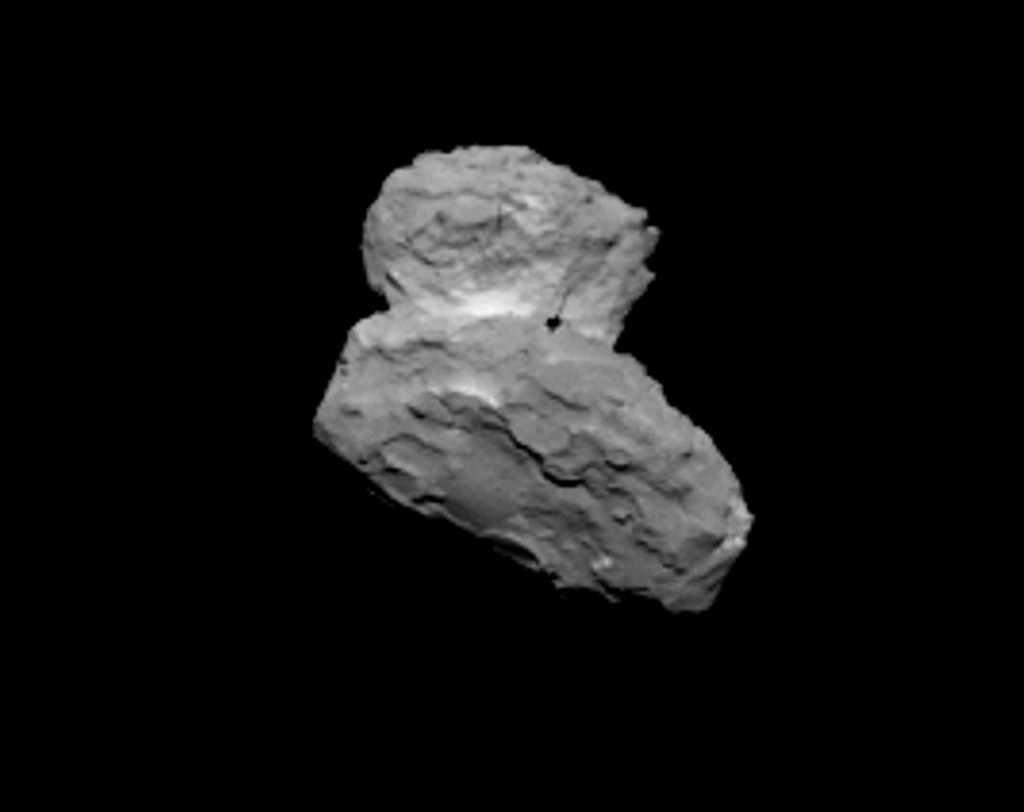
OSIRIS narrow angle camera view of 67P/C-G from a distance of 1000 km on 1 August 2014. Credits: ESA/Rosetta/MPS for OSIRIS Team MPS/UPD/LAM/IAA/SSO/INTA/UPM/DASP/IDA
If this image is rotated approximately 150 degrees, the orientation of the comet is pretty close to that of the 1 August NAVCAM image (distance 1026 km), and thus the two images from the two cameras can be directly compared. Note that, similar to the dark spot artefact in this OSIRIS image, the 1 August NAVCAM image displays white/black artefact spots.
A nice update on a hot Saturday just four days before arrival – time to really get excited!

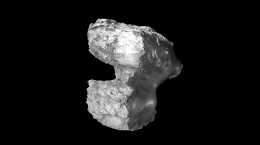
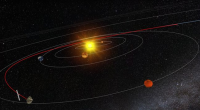
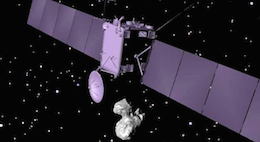

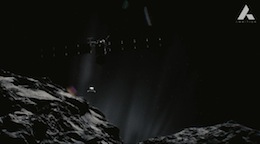
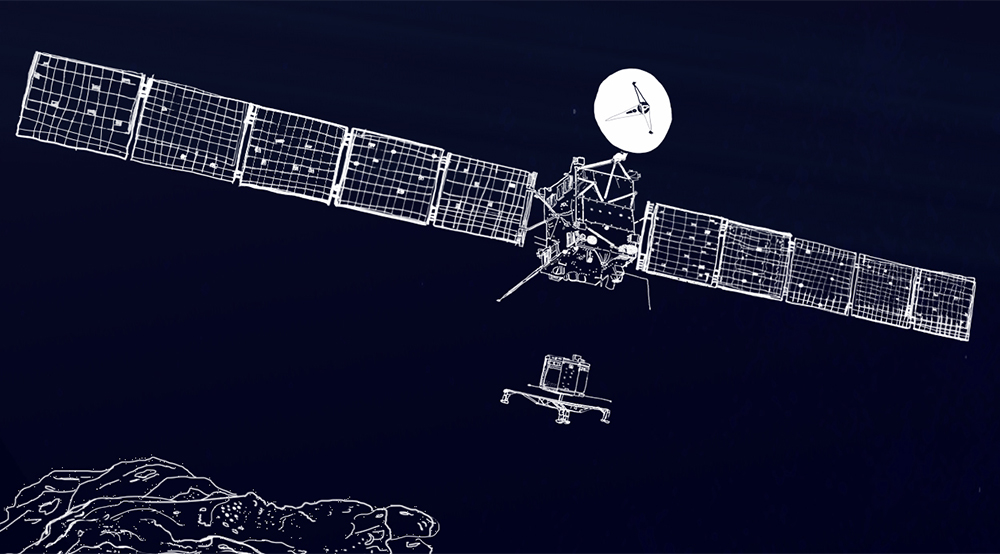
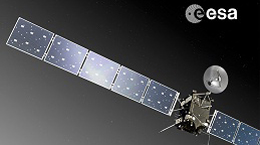
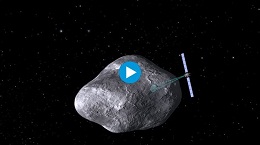
Discussion: 43 comments
Happy orbit insertion Rosetta 😉
Thanks very much for releasing this s quickly. The gradual unveiling of a new world is always so exciting!
More or less a 4 km wide object located in Madrid as seen from Paris… Not bad! 🙂
Why these small artefacts? Are they produced by some CCD defects or by some quick processing of the raw images (or are they maybe unprocessed raw images)?
A pretty rugged surface… but at least some smooth spots on the large chunk maybe for Philae? Let’s run closer to discover what’s going on over these strange potatoes…
This is an unprocessed raw image.
Raw images, wow!
Wonderful to see something so far away so close. Will be great fun to see what sort of crazy orbit Rosetta will take around such an irregular object and what details will stand out in close-up.
Whatever could be holding that narrow neck of contact together? Has Rosetta worn away into this peculiar shape by random collisions? Or is this our first look at how two nearby low-mass objects agglomerate? I suppose we’ll begin to get those answers––and new puzzles––soon!
What is CDD?
CCD: charged coupled device. It’s the image sensor, CCD defining the specific architecture in which it’s realized.
https://en.wikipedia.org/wiki/Charge-coupled_device
CCD is the equivalent of ‘film’ in any digital camera.
The photons hitting each pixel force electrons (Charge) into the data circuits, which are then saved as a file, and sent back to earth.
That black spot doesn’t look like an artefact. If you compare this image with the one from 26 July, also from OSIRIS, the location of the “artefact” on the comet is identical. Also, the proportions look right. That’s very unlikely to occur with an artefact.
Look also on the excellent NavCam image too, the black spot is still there.
Thank you so very much for releasing this jaw dropping image so promptly. Incredible. 😀
Well…lets see. The dedicated folks working on this project have a decade invested and this latest image to closely examine. Were it not an artifact they would likely reserve judgement and/or not comment until some more detailed images arrive. It could be a buergerite meteor I suppose…
i love it, very nice picture 🙂 DANKE! from germany 🙂
I hope we get more and more Picture 🙂
Grüße Christan
In the interpolated image from NAVCAM does not appear the black smudge, but the other artefacts there are always in white-black pairs. What are the differences between these?
Can’t wait for this . Pictures up close of an asteroid, future level stuff.
-Vancouver
What is the direction of the Sun in this image? Judging from the shadows It seems to be shining from the top of the image, and from an angle above the plane of the image, but it is not easy to see how big that angle is.
The Sun is shining from the top.
The sun has been behind Rosetta’s direction of approach with respect to the target. The situation is similar to a snapshot made with an old camera with an attached flashbulb – the illumination is striking the subject from nearly the same direction has the camera itself. Another example: think Full Moon.
Fantastic image. I heartily applaud ESA’s decision to release this and other Rosetta imagery in order to engage the public in both the wonder & the scientific importance of this mission. Hopefully this will now be standard policy for this and all future ESA endeavors!
Artefacts in CCD cameras are pixels which are either dead pixels or pixels which are permanently high because they have most likely been damaged by high energy cosmic rays .
Sohajek: jsem fotograf;
Je s podivem, že i z 1000 km není Osiris schopný ten slepenec zaostřit;
pravděpodobně, jak byla tmavá kometa exponovaná -1.fokus, 2.expozice a 3.citlivost ‘filmu’- něco se muselo /’dík’ třem výše jmenovaným faktorům/ – ‘ošulit’..
Nejostřejší částí se zdá být střed otáčení kolem těžiště, které se jevilo relativně nejstálejší;
Myslím ale, že čím bude Roseta blíž ke kometě, budou fotky víc rozmazanější – pokut nebude Osiris snímat zrovna střed těžiště…
Je s podivem, že i z 1000 km není Osiris schopný ten slepenec zaostřit;
pravděpodobně, jak byla tmavá kometa exponovaná -1.fokus, 2.expozice a 3.citlivost ‘filmu’- něco se muselo /’dík’ třem výše jmenovaným faktorům/ – ‘ošulit’..
Nejostřejší částí se zdá být střed otáčení kolem těžiště, které se jevilo relativně nejstálejší;
Myslím ale, že čím bude Roseta blíž ke kometě, budou fotky víc rozmazanější – pokut nebude Osiris snímat zrovna střed těžiště…
No other words than ‘Absolutely fabulous !’ > Thanks for sharing this with us all.
Amazing image , can’t wait for more of them … for sure i will follow step by step this mission , waited for so long….
Do the two lobes have different polarities? That black spot is in the neutral zone.
600 miles away, and it looks BIG. Imagine one of these hitting the Earth at high speed. I’m an OLD man, but I want to last another year to see what Philae does. Its all too exciting. Well done ESA!
hang in there bud
This is spectacular. What strikes me is that much of the surface appears to be quite rough and craggy, especially evident near the limb of both members. However, there is an intriguing smooth dome-like pile or bulge (probably dust?) on the larger member at the spot directly antipodal to its companion. Looking forward to upcoming hi-res views of the contact region, to see how rubble and dust has adjusted itself as these two bodies shifted with respect to one another. This looks to be a wonderful opportunity to see how impact and dynamic erosional debris settles on irregular contact binary objects.
Potrebbe non trattarsi di due corpi che si sono aggregati insieme, ma di un corpo originariamente dotato di uno strato più ricco di elementi volatili e quindi più attivo. La perdita di massa prevalente su questo strato, potrebbe aver conferito la forma che osserviamo.
Fantastic image. Can you explain why the distance to target is 1000 km, yet it will take several days to arrive?
They need to approach very slowly and carefully – if they went faster, then they’d have to stop very suddenly when they got close (and hope that they judged it right!)
Because Rosetta needs to slow down enough to not overshoot the comet, and eventually for the comet’s extremely feeble gravity to capture Rosetta, so the final approach will be at walking pace.
Thanks to Dave and Andrew…
Merci beaucoup !
Grâce à vous, nous sommes à la fois Christophe Colomb et Jean-François Champollion !
I would like to know which of the structures were
created fresh during the cometary activites a few
months ago. IS it possible to determine that?
Thanks again for the photo!
Ingo.
I want to say a huge Thank You to Daniel for taking time out of his weekend to provide this incredible update for us.
Wonder where the active vents are located? I know it produces a coma having seen it visually on previous approaches.
It’s very beautiful !
Well done Rosetta and thank you to all those involved in this exceptional project.
Amazing views from Down-Under.
Impatient to see and learn more about it!
Very spetacular picture anyway!
Congratulations to the whole team and … Good luck!
Fascinating stuff ESA! Good to see Europeans in the lead again. I wish you well with the mission and look forward with great interest to the upcoming rendezvous!
‘May the Force be with you’……
HI great picture that dark spot looks to me like a hole straight through the comet